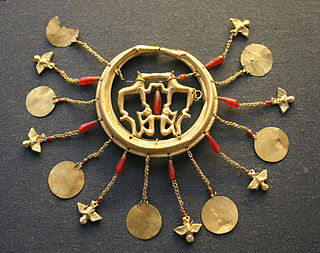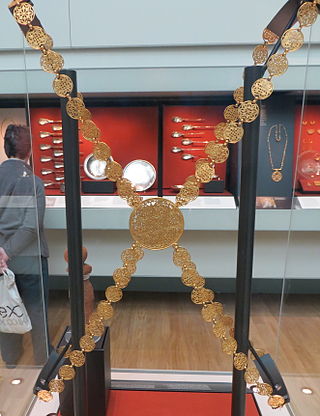
Jewellery consists of decorative items worn for personal adornment, such as brooches, rings, necklaces, earrings, pendants, bracelets, and cufflinks. Jewellery may be attached to the body or the clothes. From a western perspective, the term is restricted to durable ornaments, excluding flowers for example. For many centuries metal such as gold often combined with gemstones, has been the normal material for jewellery, but other materials such as glass, shells and other plant materials may be used.

The Germanisches Nationalmuseum is a museum in Nuremberg, Germany. Founded in 1852, it houses a large collection of items relating to German culture and art extending from prehistoric times through to the present day. The museum is Germany's largest museum of cultural history. Out of its total holding of some 1.3 million objects, approximately 25,000 are exhibited.

The Ziwiye hoard is a treasure hoard containing gold, silver, and ivory objects, also including a few gold pieces with the shape of human face, that was uncovered on in Ziwiyeh plat near Saqqez city in Kurdistan Province, Iran, in 1947.

Domagnano is a municipality in San Marino. It has 3,565 inhabitants in an area of 6.62 km2.

Pietroasele is a commune in Buzău County, Muntenia, Romania, known for its vineyards. The name means "the rockies". The commune is composed of six villages: Câlțești, Clondiru de Sus, Dara, Pietroasa Mică, Pietroasele and Șarânga. It became famous with the discovery in 1837 of the Pietroasa Treasure composed of several pieces of gold and precious stones. The Romanian historian Alexandru Odobescu wrote a book on the archaeological discovery.

The Pietroasele Treasure found in Pietroasele, Buzău, Romania, in 1837, is a late fourth-century Gothic treasure that included some twenty-two objects of gold, among the most famous examples of the polychrome style of Migration Period art. Of the twenty-two pieces, only twelve have survived, conserved at the National Museum of Romanian History, in Bucharest: a large eagle-headed fibula and three smaller ones encrusted with semi-precious stones; a patera, or round sacrificial dish, modelled with Orphic figures surrounding a seated three-dimensional goddess in the center; a twelve-sided cup, a ring with a Gothic runic inscription, a large tray, two other necklaces and a pitcher. Their multiple styles, in which Han Chinese styles have been noted in the belt buckles, Hellenistic styles in the golden bowls, Sasanian motifs in the baskets, and Germanic fashions in the fibulae, are characteristic of the cosmopolitan outlook of the Cernjachov culture in a region without defined topographic confines.

The Cheste hoard is an Iberian hoard discovered near the town of Cheste, Valencia, Spain, in 1864. Dating to about 200 BCE, the hoard was found buried in two pots and contained gold jewellery, silver coins and silver ingots. It is currently held in the Valencia History Museum.

The Treasure of El Carambolo was found in El Carambolo hill in the municipality of Camas, 3 kilometers west of Seville, on 30 September 1958. The discovery of the treasure hoard spurred interest in the Tartessos culture, which prospered from the 9th to the 6th centuries BCE, but recent scholars have debated whether the treasure was a product of local culture or of the Phoenicians. The treasure was found by Spanish construction workers during renovations being made at a pigeon shooting society.

The Aegina Treasure or Aigina Treasure is an important Minoan gold hoard said to have been found on the island of Aegina, Greece. Since 1892, it has been part of the British Museum's collection. It is one of the most important groups of Minoan jewellery.

The Carthage Treasure is a Roman silver hoard, which was found in Tunis, Tunisia, at the site of the ancient city of Carthage. The treasure principally consists of silver tableware and jewellery, most of which is now held at the British Museum.

The Beaurains Treasure is the name of an important Roman hoard found in Beaurains, a suburb of the city of Arras, northern France in 1922. Soon after its discovery, much of the treasure was dispersed, to be sold on the antiquities market. The largest portion of the hoard can be found in the local museum in Arras and in the British Museum.

The Sutri Treasure is an important Lombardic hoard found at Sutri, Italy in the late nineteenth century that is currently in the collections of the British Museum in London.

The Artres Treasure is an important Merovingian hoard found at Artres, northern France in the nineteenth century. Most of the treasure is now in the collection of the British Museum in London.

The Belluno Treasure is an important Lombardic hoard found at Belluno, Italy in the nineteenth century that has been part of the British Museum's collection since 1897.

The Bergamo Treasure is a large Lombardic and Ostrogothic hoard found near the city of Bergamo in northern Italy in the nineteenth century. It was mostly acquired by the British Museum in 1897.

The Boscoreale Treasure is a large collection of exquisite silver and gold Roman objects discovered in the ruins of the ancient Villa della Pisanella at Boscoreale, near Pompeii, southern Italy. Consisting of over a hundred pieces of silverware, as well as gold coins and jewellery, it is now mostly kept at the Louvre Museum in Paris, although parts of the treasure can also be found at the British Museum.

The Asyut Treasure is the name of an important Byzantine hoard of jewellery found near the city of Asyut, central Egypt. Discovered in mysterious circumstances in the early twentieth century, the treasure is now divided between the Kunstgewerbemuseum in Berlin, the British Museum in London and the Metropolitan Museum in New York City.

Set of jewelry, also known as the Vulci group is a set of 5th century BCE Etruscan metalwork collection by an unknown jeweler. It is in the collection of the Metropolitan Museum of Art.
The Castellani were a family of goldsmiths, collectors, antique dealers and potters who created a business "empire" active in Rome during the 18th and 19th centuries.
 Part of the Domagnano Treasure displayed in the British Museum
Part of the Domagnano Treasure displayed in the British Museum

























